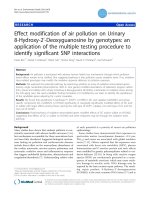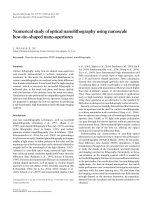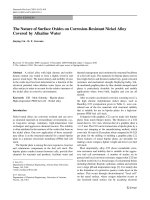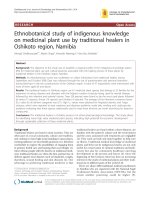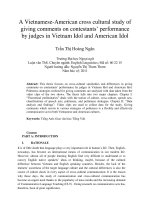Study of micro grinding of glass using on machine fabricated polycrystalline diamond (PCD) by micro EDM
Bạn đang xem bản rút gọn của tài liệu. Xem và tải ngay bản đầy đủ của tài liệu tại đây (6.42 MB, 195 trang )
STUDY OF MICRO-GRINDING OF GLASS USING ON-
MACHINE FABRICATED POLYCRSYTALLINE
DIAMOND (PCD) BY MICRO-EDM
ASMA PERVEEN
(B.Sc. in Mechanical Engineering, BUET)
A THESIS SUBMITTED
FOR THE DEGREE OF DOCTOR OF PHILOSOPHY
DEPARTMENT OF MECHANICAL ENGINEERING
NATIONAL UNIVERSITY OF SINGAPORE
2012
Declaration
i
Declaration
I hereby declare that the thesis is my original work and it has been written by me in
entirely.
I have duly acknowledged all the source of information which have been used in this
thesis.
This thesis has also not been submitted for any degree in any university previously.
Acknowledgments
ii
Acknowledgments
I wish to express my deepest and heartfelt gratitude and appreciation to my Supervisors,
Professor Wong Yoke San and Professor Mustafizur Rahman for their valuable guidance,
unconditional support, continuous encouragement and for being the source of inspiration
throughout the tenure. Their comments and advice during the research have contributed
immensely towards the success of this work. In addition, their patient guidance and
suggestions have also helped me in learning more.
I would also like to take this opportunity to show my thanks to the National University of
Singapore (NUS) for supporting my research by providing the research scholarship and to
the Advanced Manufacturing Lab (AML) and Micro Fabrication Lab for the state of the
art facilities and support, without which this present work would not be possible.
I owe my deepest gratitude to the following staffs for their sincere help, guidance and
advice: Mr. Tan Choon Huat, Mr. Lim Soon Cheong, Mr. Wong Chian Long, Mr.
Sivaraman Selvakumar and Mr. Yeo Eng Haut, Nelson from Advanced Manufacturing
Lab (AML). Special thanks go to Mr. Tanveer Saleh and Javahar from Mikrotools, a
NUS spin off company, for their help with the machine set-up and technical assistance
provided during different period of my research.
I would like to offer my appreciation for the support and encouragement during various
stages of this research work to my lab mates and friends. My appreciation goes to
Mohammad Pervej Jahan, Mohammed Muntakim Anwar, Rajib Saha, Mohammad Ahsan
Habib, Fahd Ebna Alam, Tamanna Alam, Aklima Afzal, Kazi Monzure Khoda, Aziz
Ahmed, Saikat Das, Mohammad Iftekher Hossain, Aslam Hossain, Jahidul Islam, Md.
Mazharul Haque, Ashim Kumar Debnath, Saidur Rahman Bakaul, Mahjabeen Sultana,
Chandra Nath, Indraneel Biswas, Muhammad Tarik Arafat, Anower Hossain, Wang Xue,
Jingjing, Dang, Xinqian, Arif, Chanaka Dilhan Senanayake, Lubecki Tomasz Marek,
Acknowledgments
iii
Subrata Saha, Khalid, Rumki, Jerry, Ranjan, Sujib and many more. Special thanks to all
of them for being so supportive for the past four years. Last but not the least, my heartfelt
gratitude goes to my dearest mother Mrs. Anowara Begum, for her loving
encouragement and best wishes throughout the whole period and my father, Md. Ruhul
Amin Khan, for his mental support and encouragement that kept me strong to face
numerous challenges. I am also deeply indebted to my loving elder sisters, Nasima Khan
Bakul, and Sabina Yesmin Bina for their inspiration and my brothers, Hasnanur Rahman
Shadeen, Sakin Amin Khan and Jubaed Hossain, for always being there for me. Without
them this journey might not be possible. I will be ever grateful to them for their kind
support.
Table of Contents
iv
Table of Contents
DECLARATION I
ACKNOWLEDGMENTS II
TABLE OF CONTENTS IV
SUMMARY VII
NOMENCLATURE IX
LISTS OF FIGURES XI
LISTS OF TABLES XIV
CHAPTER 1 1
INTRODUCTION 1
1.1. MACHINING OF GLASS AND CERAMICS: IMPORTANCE AND CHALLENGES 1
1.1.1. Importance 1
1.1.2. Challenges in machining of Glass 1
1.3 BACKGROUND (MOTIVATION) 3
1.4.SIGNIFICANCE OF RESEARCH 7
1.5. RESEARCH OBJECTIVES 9
1.5.ORGANIZATION OF THESIS 10
CHAPTER 2 12
LITERATURE REVIEW 12
2.1. INTRODUCTION 12
2.2. GLASS MACHINING 12
2.2.1. Application of Glass Microstructures 12
2.2.2. Fabrication of Glass Microstructures 13
2.3. FUNDAMENTALS OF GRINDING AND CUTTING PRINCIPLE 15
2.3.1. Ductile regime machining 15
Principle of ductile regime machining 16
Material removal mechanisms in ductile regime machining 18
2.3.2. Material removal in glass and ceramics 19
2.3.3. Subsurface mechanical damage 22
2.3.4. Tool wear 29
2.4. MICRO-EDM 32
2.4.1. Principles of EDM 35
2.4.2. Micro-EDM and Its Types 35
2.4.3. Advantages of micro-EDM over other micromachining processes 37
2.5. CONCLUDING REMARKS ON THE LITERATURE REVIEW 37
CHAPTER 3 39
EXPERIMENTAL SETUP AND METHODOLOGY 39
3.1 INTRODUCTION 39
3.2 EXPERIMENTAL SETUP 39
3.2.1. Multi-purpose Miniature Machine Tool 39
3.2.2. Work piece material 42
3.2.3. Electrode material For PCD 43
Table of Contents
v
3.2.4. Dielectric fluid 44
3.3. EXPERIMENTAL PROCEDURES 45
3.3.1. Micro-electrode fabrication 45
3.3.2. Micro-grinding of Glass 45
3.4. EQUIPMENT USED FOR MEASUREMENT AND ANALYSIS 46
3.4.1. Atomic force Microscope (AFM) 47
3.4.2 Scanning Electron Microscope (SEM) and Energy Dispersive X-ray (EDX) Machine 48
3.4.3 Keyence VHX Digital Microscope 48
3.4.4 Taylor Hobson Machine 49
CHAPTER 4 51
EXPERIMENTAL STUDIES OF MICRO-GRINDING OF GLASS 51
4.1. INTRODUCTION 51
4.2.METHODOLOGY 54
4.3.ON-MACHINE FABRICATION OF PCD TOOL USING MICRO-EDM 54
4.3.1.Effect of Gap Voltage 55
4.3.2.Effect of Capacitance 57
4.3.3.Effect of Depth of Feed in Each Step 58
4.4.EFFECT OF FABRICATED PCD TOOL SURFACE ON GLASS MICRO GRINDING 58
4.5.COMPARATIVE MICRO GRINDING PERFORMANCE OF BK7, LITHOSIL AND N-SF14 GLASSES 62
4.5.1.Comparison of Cutting Forces 62
4.5.2.Comparison of Surface Roughness 68
4.6.CONCLUDING REMARKS 74
CHAPTER 5 76
EFFECTS OF CUTTING TOOL GEOMETRY ON THE GLASS MICRO-GRINDING PROCESS
76
5.1. INTRODUCTION 76
5.2. METHODOLOGY 77
5.3 FABRICATION OF DIFFERENT GEOMETRY OF MICRO TOOLS IN SINGLE SETUP 78
5.3.1 Design and Fabrication of Fixture 78
5.4. COMPARISON ON MICRO-GRINDING PERFORMANCE OF DIFFERENT SHAPE TOOL ON BK7 GLASS 82
5.4.1 Comparison of Cutting Forces 82
5.4.2 Comparison of Surface Roughness 88
5.4.3 Comparison of Tool Wears 92
5.5. CONCLUDING REMARKS 94
CHAPTER 6 96
ANALYSIS AND MONITORING OF WEAR OF PCD MICRO-TOOL 96
6.1. INTRODUCTION 96
6.2. METHODOLOGY 97
6.3. RESULTS AND DISCUSSIONS 98
6.3.1. Tool wear pattern 98
6.3.2. Effect of tool wear on micro-ground surfaces 108
6.3.3. Analysis of Chips 111
6.3.4. Online monitoring of tool wear by using Normal force and AE signal 112
6.4. CONCLUDING REMARKS 116
CHAPTER 7 118
SUBSURFACE DAMAGE ANALYSIS OF GLASS 118
7.1. INTRODUCTION 118
7.1.1. Subsurface Damage 119
7.1.2. Subsurface Damage Evaluation Techniques 121
Table of Contents
vi
7.2. EXPERIMENTAL DETAILS 122
7.2.1. Work piece Preparation 123
7.2.2. Tool Preparation 125
7.3. RESULTS AND DISCUSSION 125
7.3.1. Ground Surface Characteristics 125
7.3.2. Grinding Induced Subsurface Damage 128
7.3.3. Subsurface Crack Configuration 135
7.3.4. Analysis of Surface Roughness 138
7.4. CONCLUDING REMARKS 140
CHAPTER 8 142
MODELING OF VERTICAL MICRO GRINDING 142
8.1 INTRODUCTION 142
8.2 MODELING OF CHIP FORMATION 143
8.3. MODELING OF CHIP FORMATION FORCE FOR INDIVIDUAL GRAIN 148
8.4. MODELING OF PLOUGHING FORCE FOR INDIVIDUAL GRAIN 150
8.5. MODELING OF GRINDING FORCE 152
8.6. SIMULATION AND VERIFICATION OF THE MODEL 153
8.7 STATISTICAL ANALYSIS 157
8.8. CONCLUDING REMARKS 158
CHAPTER 9 159
CONCLUSIONS, CONTRIBUTIONS AND RECOMMENDATIONS 159
9.1 CONCLUSIONS 159
9.1.1 Experimental Studies of Micro-Grinding of Glass 159
9.1.2. Effects of Cutting Tool Geometry on the Glass Micro-grinding Process 160
9.1.3. Analysis and Monitoring of Wear of PCD Micro-tool 162
9.1.4. Analysis of Sub-surface Damage (SSD) Generated 163
9.2 THE RESEARCH CONTRIBUTION 165
9.2.1 The Approaches and Analysis on this New type of Micro-grinding 165
9.3 RECOMMENDATIONS FOR FUTURE RESEARCH 167
BIBLIOGRAPHY 169
LIST OF PUBLICATIONS 179
Summary
vii
Summary
This research mainly aims to study and develop a multi-process approach to improve and
enhance the machining of brittle materials like glass using a PCD tool. A combined block-EDM
and micro-grinding process is proposed where the micro-grinding process is applied to the glass
following the block-EDM operation on PCD tool. The intregrated block-EDM and micro-
grinding process is conducted in a single setup, which does not involve the taking out of the PCD
tool after fabrication and hence can improve the accuracy in the fabrication of micro-features on
glass. Firstly, the experimental investiagation has been performed to find the optimum block-
EDM parameters for the PCD tool preparation considering the better surface finish on the glass
material. Using the optimum tool, in depth investigation has been carried out to find out the
optimum grinding condtions. It is envisaged that considering the machining time, optimum
parameters for micro-EDM was found to be 120 V, 1000 pF and 30 µm feed length. An axial
depth of cut of 2 µm and feed rate of 1 µm/min was found to be optimum in terms of cutting forces
and achieved surface finish. In addition to this, BK7 glass was also found to provide better
machinability based on cutting force and surface roughness (12.79 nm) analysis among three
different kinds of glasses. Other than optimum machining condition, feasibility of fabrication of
different geometry of grinding tools along with desired size and their effect on grinding glass has
been studied. It is found that with the concept of block micro-EDM and application of the
specifically designed block, microelectrodes of conical, triangular, square or rectangular,
circular and D-shaped tool were possible to fabricate successfully in a single set-up which
eliminates the usage of another machine when different shape micro-structure is needed on the
glass material. In addition to this, it is found that the D-shape tool demonstrated better
performances among all the four tools( circular, D-shaped, triangular, square) considered in
terms of cutting force, roughness value, side surface and wear rate due to its geometry, with
enhanced chip removal form the machined surface.
Thirdly, in order to comprehend the usage time of this newly developed on-machine fabricated
PCD tool in case of glass machining, wear analysis and monitoring the wear process has been
carried out also. The G ratio for this PCD micro tool was found to be nearly 940 indicating the
greater wear resistance of the tool even against the abrasive material like glass. Edge chipping
and abrasive wear were found to take place on the tool surface in the three steps of wear
progression, which is initial, intermediate and severe. Moreover, the continuous monitoring of
Summary
viii
AE signal is found to give an indication of tool topographic condition, i.e. sharpness and
bluntness of PCD cutting edge during micro-grinding. In addition to this, glass cutting
mechanism has been investigated using surface and sub-surface condition analysis to understand
the effect of machining condition in this process. It is found that the ground surface consists of
four different types; (a) smooth; (b) fractured; (c) smeared; (d) ploughing striations. Both the
damage depth and surface roughness are found to be influenced by the depth of cut, feed rate,
and spindle speed. In addition, two major types of grinding damage have been identified to likely
be chipping damage and micro-cracking damage. Lateral, median and cone cracks are found to
be existed in the sub-surface. The crack size varies from below to above 1µm.
Finally in this thesis, a new predictive analytical modified model for micro grinding process has
been developed considering single grit interaction for calculating process force. Then, on the
basis of this predictive model, a comparison between the experimental data and analytical
prediction was performed in the case of overall micro-grinding forces in x, y and z direction.
Although, there is pretty much deviation in the predicted value of the micro grinding forces, these
differences can be reduced considering more parameters in the model which can be considered in
future work.
The research works conducted in this project will be eminently helpful to promote better
understanding while implementing this newly developed hybrid process, and to improve its
robustness in the field of precision manufacturing. The investigation conducted in this thesis will
be certainly supportive for the PCD tool users to understand the importance of choosing
fabrication parameters that works in better associations with the glass grinding parameters and
to utilize the full effectiveness of the PCD tool for precision finishing of brittle material like glass.
In addition, the combined established relation among tool wear, cutting force and AE signal is
new and useful analysis, which are more essential to necessitate offline dressing for tool wear
compensation. Morover, the knowledge of the damage generation and propagation promotes the
importance of selecting optimum parameters for finishing of a particular brittle work pieces.
Nomenclature
ix
Nomenclature
C = Capacitance (pF)
V =Gap voltage (V)
∆r-=Decrease in tool radius
G= Volume of material removal per unit volume of wheel wear
d
si
= Mean of the tool diameter before and after wear
b
1
= Grinding width
V
s
=Volume of radial wheel wear
V
w
=Volume of material removal
K
c
=Fracture toughness
H = Hardness
E = Elastic modulus
b = A constant which depends on tool geometry
y
c
. =An average depth
f = Cross-feed
d
c
=Critical penetration depth for fracture initiation
C
d(z’)
=dynamic cutting edge density
= Feed rate
h
= Minimum chip thickness
cr
= Critical rake angle
Cs(z)= Static cutting density
A= Empirical constant
Z=Radial distant measured into the wheel
c
d
= Average grain diameter
Vt= Total volume on the periphery of the wheel engaged in the work piece
Vsh= Total kinematic shadow volume generated by active cutting edge
g
N
=Total number of grain
geq
d
= Equivalent grain diameter
Nomenclature
x
c
b
= Cutting width of grain
c
a
= Cutting length of grain
t= Grain depth of cut
V=Spindle speed
HB= Brinall hardness number
brnl
f
=Indentation force
d = Ball diameter
b = Diameter of impression.
= Friction angle
=Shear angle
s
= Shear strength
cgx
f
= Chip formation force in tangential direction
cgy
f
= Chip formation force in normal direction
pgx
f
= Plough force in tangential direction
cgy
f
=Plough force in normal direction
n
f
=Force acting normal direction for each grain
t
f
=Force acting tangential direction for each grain
n
F
=Total force in normal direction
t
F
=Total force in traverse direction
l
F
=Total force in longitudinal direction
p
= Friction co-efficient
B= Work piece width
D= Tool diameter

